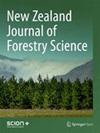Effect of chemical modification and heat treatment on biological durability and dimensional stability of Pinus roxburghii Sarg.
IF 1.1
4区 农林科学
Q2 FORESTRY
引用次数: 1
Abstract
Background: Depleting supplies of wood species with inherent natural durability has resulted in the focus being shifted to non-durable plantation grown and imported timber. Despite its abundant availability and better treatability, the use of Pinus roxburghii is limited to packing cases, crates, shutters, door and window frame, carpentry and joinery items due to its nondurable nature. Hence, to promote use of such timber for applications such as decking, cladding and facade elements chemical modification with a combination of citric acid and sodium hypophosphite, and heat treatment were explored to improve its service life. Methods: Chemical modification was performed using a water solution of citric acid (6.9%) and sodium hypophosphite (6.5%) followed by curing at 140°C for 8 hrs. Dimensional stability was determined by estimating the volumetric swelling coefficient and anti-swelling efficiency (ASE) of treated and control samples. Durability against fungus and termites was evaluated using a soil block bioassay and termite mound test as per standard methods. Results: Both chemical modification and heat treatment of P. roxburghii resulted in enhanced dimensional stability and biological durability compared to the untreated controls. Chemical modification and heat treatment resulted in 23.05% and 18.37% volumetric ASE, respectively. Results showed that a highly perishable species became significantly more durable after chemical modification, exhibiting 5–6 times less mass loss by termites in comparison to the controls. Wood samples modified with citric acid showed excellent resistance to both white and brown rot fungi and exhibited 14-15 times less reduction in mass compared with untreated samples. Conclusions: Citric acid chemical modification is an environment friendly process that improved the dimensional stability as well as resistance against biodegradation. These studies may provide valuable inputs to establish this mode of chemical modification as a cost-effective alternative to other chemicals for wood preservation. The concentrations of the chemicals and temperature for fixation may be varied to establish an optimum combination for best output.化学改性和热处理对刺梨松生物耐久性和尺寸稳定性的影响。
背景:具有固有自然耐久性的木材种类的供应不断减少,导致重点转移到非耐久种植园种植和进口木材上。尽管刺梨有丰富的可用性和更好的可处理性,但由于其不耐用的性质,刺梨的使用仅限于包装箱、板条箱、百叶窗、门窗框架、木工和细木工制品。因此,为了促进此类木材在甲板、覆层和立面元素等应用中的使用,探索了用柠檬酸和次磷酸钠组合进行化学改性和热处理以提高其使用寿命。方法:使用柠檬酸(6.9%)和次磷酸钠(6.5%)的水溶液进行化学改性,然后在140°C下固化8小时。通过估计处理样品和对照样品的体积膨胀系数和抗膨胀效率(ASE)来确定尺寸稳定性。根据标准方法,使用土块生物测定和白蚁丘试验来评估对真菌和白蚁的耐久性。结果:与未处理的对照组相比,刺梨的化学改性和热处理均提高了其尺寸稳定性和生物耐久性。化学改性和热处理分别产生23.05%和18.37%的体积ASE。结果表明,一种高度易腐的物种在化学改良后变得更加耐用,与对照相比,白蚁造成的质量损失减少了5-6倍。用柠檬酸改性的木材样品对白腐真菌和褐腐真菌都表现出优异的抗性,并且与未处理的样品相比,质量减少了14-15倍。结论:柠檬酸化学改性是一种环境友好的工艺,可以提高尺寸稳定性和抗生物降解性。这些研究可能为建立这种化学改性模式提供有价值的投入,将其作为木材防腐的其他化学品的一种具有成本效益的替代品。化学物质的浓度和用于固定的温度可以变化,以建立最佳输出的最佳组合。
本文章由计算机程序翻译,如有差异,请以英文原文为准。
求助全文
约1分钟内获得全文
求助全文
来源期刊

New Zealand Journal of Forestry Science
FORESTRY-
CiteScore
2.20
自引率
13.30%
发文量
20
审稿时长
39 weeks
期刊介绍:
The New Zealand Journal of Forestry Science is an international journal covering the breadth of forestry science. Planted forests are a particular focus but manuscripts on a wide range of forestry topics will also be considered. The journal''s scope covers forestry species, which are those capable of reaching at least five metres in height at maturity in the place they are located, but not grown or managed primarily for fruit or nut production.
 求助内容:
求助内容: 应助结果提醒方式:
应助结果提醒方式:


